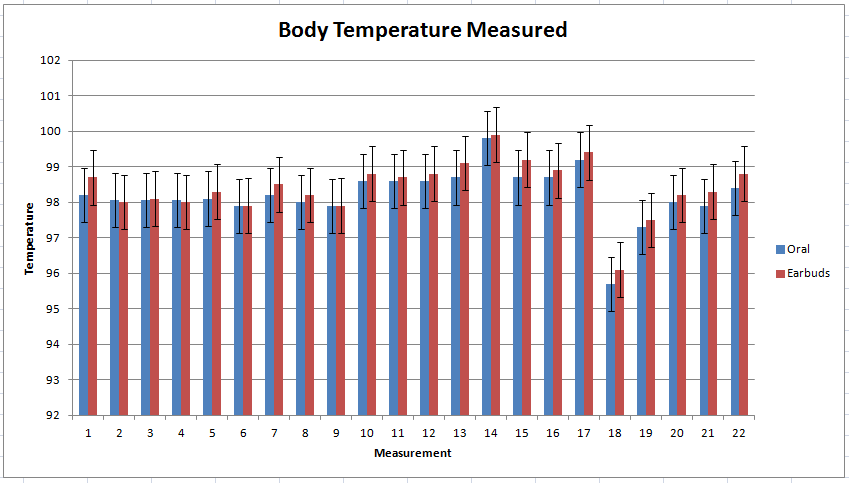BME100 f2013:W900 Group5 L3
| Home People Lab Write-Up 1 | Lab Write-Up 2 | Lab Write-Up 3 Lab Write-Up 4 | Lab Write-Up 5 | Lab Write-Up 6 Course Logistics For Instructors Photos Wiki Editing Help | ||||||
|
OUR TEAM
LAB 3A WRITE-UPDescriptive StatisticsAccording to our data, the information received from the Raiing device is inaccurate. On average, the sensor was off by about 1.8 degrees in comparison to the oral thermometer. However that is only average, and there were some extreme outliers that occured and in some cases the device did not even function for some people.
Results
AnalysisThe data shown above indicates several things about the medical device and its overall performance. One clear idea that can be taken away from the testing of the surface thermometer is that it has a high degree of variance in respect to it's environment and the patients true body temperature. The epidermal thermometer did a reasonable job when it came to measuring body temperature when the subject was stationary and out of the sun. However if the subject was to ever sweat profusely then the degree of variance would differ drastically and this is due to the products overall external design. Another huge problem with the product is the concept of range going out on the device and this can be seen in the data. Generally when the temperature had a higher difference, it meant that everything had to be halted and then the monitor had to be readjusted. This device did a good job at measuring body temperature within a few degrees of actual body temperature, which in all actuallity is bad considering a few degrees above the average human body temperature would mean they have a high fever.
Summary/DiscussionBased on the results of taking both inside and outside readings using the Raiing device, it gave very inaccurate measurements due to the fact that it measures surface temperature and not core temperature and does not account for the weather and how our body reacts in different temperatures by passively cooling and heating our bodies to find equilibrium. However, the difference in surface temperature varies based on the temperature of the environment. The statistical analysis just by looking at the data shows a wide variance between the different groups. Many of the groups showed no data, which means either there was a faulty internal portion within the system or that the device could not function in the proximity of other blue tooth signals/devices. Either of these errors would disrupt the functionality of a device and render it useless. Just from the initial testing, I am able to conclude that a method of measuring the external temperature of the body is a valid use for this product, which should be stated, due to the fact that the Raiing device is external and cannot get a reading based on core temperature. Also, as unlikely as it may seem, it could remain in shade on a single part of the body when walking in long durations in a given north/South direction and be completely out of sunlight. The difference would be minimal, but if a crucial use of the device comes into effect at any point it would be flawed.
LAB 3B WRITE-UPTarget Population and NeedDesigned for athletes, coaches, athletic trainers,physical therapists or even soldiers in the field. The purpose of the device is to measure a subjects temperature from the ear, but also the wrap around sensor can be used as a portable ballistocardiogram(is a measure of ballistic forces on the heart) and also a method to measure a subjects heart rate due to the proximity of the device location and the carotid artery. Now the need for such a device can come from many different fields, but the main purpose would be to monitor an athletes performance through their body temperature/blood pressure and heart rate. These can all be read from a trainer/coaches device to show statistics amongst a team. It can be used to also maximize performance and whether or not someone should have to increase intesity. Yet for the military application, it can measure stress vitals of soldiers in the field, and be able to monitor a platoon or a garrison of troops from a portable hotspot carried in their backpack.
Device Design
Inferential StatisticsBased on the graph of the device's functionality, we can determine that temperature measured through the ear is regularly within a degree or two from your oral temperature. Random variation from within this statistics can be affected by the time of day, regardless of what time it is taken, the trials would all have to be taken within the same time interval of the same day because outside conditions vary from day to day. Another thing that could affect temperature is the amount of earwax the subject has could affect temperature within the ear and keep it at a much lower level. However after doing some research, it was discovered that Tympanic temperature normally varies by a degree from a subjects oral temperature, but is normally in sync with a rectal themometer. All of this varies though, considering we used randomized statistics for our dataset and it is subject to change by human error before any testing could be completed, considering we made an assumption that the variance would be by a degree or so from the oral temperature.
Graph
| ||||||




